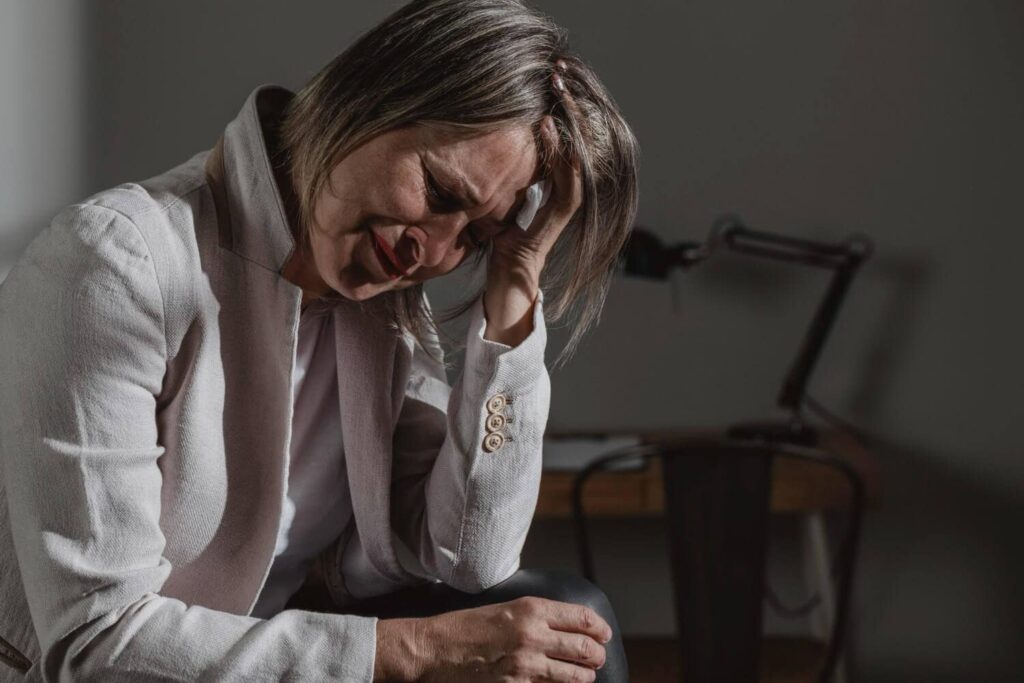Panic Attack or Anxiety Attack? Key Differences You Should Know
Clinically Reviewed by Dr. Kate Smith

Understanding the difference between a panic attack and an anxiety attack is crucial for managing and coping with these overwhelming experiences. While both involve feelings of fear and anxiety, they differ in intensity, duration, and triggers.
What is a Panic Attack?
A panic attack is characterized by a sudden and overwhelming surge of intense fear or discomfort. These episodes typically reach a peak within minutes and can be accompanied by a range of physical symptoms, including:
-
Common physical symptoms include:
While the experience can be overwhelming, it’s essential to remember that panic attacks are not life-threatening.
-
- Rapid heartbeat
- Sweating
- Trembling or shaking
- Shortness of breath or feeling like you’re choking
- Chest pain or discomfort
- Nausea or upset stomach
- Dizziness, lightheadedness, or faintness
- Chills or hot flashes
- Numbness or tingling sensations
- Derealization (feeling detached from reality) or depersonalization (feeling detached from oneself)
- Emotional symptoms often accompany these physical sensations and may include:
- Fear of dying or losing control
- Feeling like something terrible is about to happen
Causes of Panic Attacks: A Deeper Look
Genetics
A family history of anxiety disorders, particularly panic disorder, can significantly increase your risk of experiencing panic attacks. Research suggests that there may be a genetic predisposition to developing these conditions. If close relatives have struggled with panic or anxiety, it’s essential to be aware of your potential vulnerability.
Brain Chemistry
The intricate balance of neurotransmitters in your brain plays a crucial role in mood regulation. Imbalances in chemicals like serotonin and norepinephrine have been linked to panic attacks. These neurotransmitters influence how your brain processes information and responds to stress. When these chemicals are out of sync, it can contribute to feelings of anxiety and fear.
Environmental Factors
Life is filled with ups and downs, and significant stressors can serve as triggers for panic attacks. Examples of such stressors include:
- Major life changes: Divorce, job loss, moving, or the birth of a child can be overwhelming.
- Trauma: Experiencing a traumatic event, such as a car accident, natural disaster, or assault, can leave lasting emotional scars.
- Ongoing stress: Chronic stress from work, relationships, or financial burdens can contribute to the development of panic attacks.
Substance Abuse
Alcohol and drugs can disrupt the delicate balance of your brain chemistry, increasing the likelihood of experiencing panic attacks. Substances like stimulants and hallucinogens can trigger anxiety and paranoia, mimicking the symptoms of a panic attack. Moreover, withdrawal from alcohol or drugs can also induce panic-like symptoms.
Medical Conditions
Certain medical conditions can manifest symptoms that resemble panic attacks. These conditions often require medical attention and treatment. Examples include:
- Hyperthyroidism: An overactive thyroid gland can cause rapid heart rate, sweating, and trembling.
- Heart disease: Conditions like angina or arrhythmias can produce chest pain and shortness of breath.
- Respiratory disorders: Asthma or chronic obstructive pulmonary disease (COPD) can lead to difficulty breathing.
If you’re experiencing panic-like symptoms, it’s crucial to consult with a healthcare professional to rule out any underlying medical conditions.
Side Effects and Risks of Panic Attacks
While panic attacks are not inherently harmful, their impact on an individual’s life can be significant. The fear and anxiety associated with these attacks can lead to a range of negative consequences:
- Agoraphobia: A fear of places or situations that might induce panic, leading to avoidance behaviors and social isolation.
- Depression: The constant worry and stress of experiencing panic attacks can contribute to the development of depressive symptoms.
- Impaired daily functioning: Panic attacks can disrupt work, school, and relationships, affecting overall quality of life.
- Physical health problems: Chronic stress from panic attacks can exacerbate existing health conditions or contribute to new ones.
- Substance abuse: As a way to cope with anxiety, some individuals may turn to alcohol or drugs, leading to addiction.
Prevalence of Panic Attacks
Panic attacks are surprisingly common. While exact figures can vary based on studies and populations, it’s estimated that:
- Up to 11% of people experience a panic attack at some point in their lives.
- Approximately 2-3% of the population develops panic disorder, characterized by recurrent unexpected panic attacks.
It’s important to note that:
- Women are twice as likely as men to develop panic disorder.
- Panic attacks can occur at any age, but often emerge during adolescence or young adulthood.
Despite the high prevalence, many people with panic attacks hesitate to seek help due to stigma or fear. It’s essential to remember that panic attacks are treatable, and seeking support can significantly improve quality of life.
What is an Anxiety Attack?
Unlike panic attacks, which are sudden and intense, anxiety attacks tend to develop more gradually and persist for a longer duration. They are characterized by overwhelming feelings of apprehension, worry, and unease. While anxiety is a normal human emotion, anxiety attacks represent an intensified and debilitating form of this experience.
General Anxiety vs. Anxiety Attacks
While both involve feelings of unease and worry, general anxiety and anxiety attacks are distinct experiences. General anxiety is a persistent state of excessive worry about everyday events. It’s a more constant companion, often lasting weeks or even months. Symptoms tend to be milder and may include:
- Excessive worrying
- Restlessness
- Fatigue
- Difficulty concentrating
- Irritability
- Muscle tension
- Sleep disturbances
Anxiety attacks, on the other hand, are intense episodes of fear or dread that build rapidly. They are often accompanied by physical symptoms like rapid heartbeat, sweating, and shortness of breath. Unlike general anxiety, anxiety attacks are typically shorter in duration, although the fear and discomfort can be overwhelming.
Signs and Symptoms of an Anxiety Attack
Anxiety attacks are characterized by a surge of intense fear or worry, often accompanied by a range of physical symptoms. While they might not escalate as rapidly as panic attacks, the discomfort and distress can be equally debilitating.
Common emotional symptoms include:
- Overwhelming sense of apprehension or dread
- Feeling restless or on edge
- Difficulty concentrating
- Irritability
- A sense of impending doom
Physical symptoms often mirror those of panic attacks but tend to be less intense:
- Rapid heartbeat
- Sweating
- Trembling or shaking
- Shortness of breath
- Muscle tension
- Fatigue
- Dry mouth
- Nausea or upset stomach
- Numbness or tingling
Causes of Anxiety Attacks
Pinpointing the exact cause of an anxiety attack can be challenging, as it often involves a combination of factors. However, several potential contributors have been identified:
- Genetics: A family history of anxiety disorders, including generalized anxiety disorder, can increase your susceptibility.
- Brain chemistry: Imbalances in neurotransmitters, such as serotonin and norepinephrine, may play a role.
- Environmental factors: Significant life stressors, ongoing challenges, or traumatic events can trigger anxiety attacks.
- Medical conditions: Certain health issues, like thyroid problems or heart conditions, can mimic anxiety symptoms.
- Substance abuse: Alcohol or drug use can exacerbate anxiety symptoms.
Side Effects and Risks of Anxiety Attacks
While anxiety attacks are not inherently harmful, their persistent presence can significantly impact an individual’s life. Some potential consequences include:
- Impaired daily functioning: Difficulty concentrating, memory problems, and trouble making decisions can hinder work, school, and social life.
- Social isolation: Fear of experiencing anxiety attacks in public may lead to avoidance behaviors and social withdrawal.
- Depression: The constant worry and stress associated with anxiety can increase the risk of developing depressive symptoms.
- Physical health problems: Anxiety can contribute to various physical ailments, such as headaches, digestive issues, and sleep disturbances.
- Substance abuse: As a coping mechanism, some individuals may turn leading to alcohol addiction or drugs addiction.
Prevalence of Anxiety Attacks
Anxiety attacks are relatively common, affecting a significant portion of the population. While exact figures can vary based on studies and diagnostic criteria, it’s estimated that:
- Approximately 31% of adults in the United States experience an anxiety disorder at some point in their lives.
- Anxiety disorders, including those characterized by anxiety attacks, affect about 18.1% of the U.S. adult population annually.
It’s important to note that:
- Women are more likely than men to develop anxiety disorders.
- Anxiety disorders can emerge at any age but often begin in childhood or adolescence.
Key Differences Between Panic Attacks and Anxiety Attacks
To summarize, panic attacks are characterized by their sudden onset, intense physical symptoms, and lack of a clear trigger. Anxiety attacks, on the other hand, are often preceded by a specific stressor and tend to be less severe. Understanding these distinctions is crucial for developing appropriate coping strategies and seeking professional help if needed.
- Onset: Panic attacks tend to strike suddenly and without warning, while anxiety attacks often develop gradually in response to a specific stressor.
- Intensity: Panic attacks are typically more intense, with physical symptoms reaching a peak within minutes. Anxiety attacks, while uncomfortable, tend to be less severe.
- Duration: Panic attacks usually last for a brief period (10-20 minutes), while anxiety attacks can persist for hours or even days.
- Fear: Panic attacks often involve a sense of impending doom or loss of control, while anxiety attacks are more focused on worry and apprehension.
Symptoms
While both panic and anxiety attacks share some overlapping symptoms, there are key distinctions:
- Panic Attacks: Characterized by intense fear or discomfort that peaks rapidly, often accompanied by physical symptoms like rapid heartbeat, sweating, trembling, shortness of breath, chest pain, and dizziness.
- Anxiety Attacks: Involve a more generalized sense of fear or apprehension, with symptoms like restlessness, fatigue, difficulty concentrating, irritability, muscle tension, and sleep disturbances.
Triggers
- Panic Attacks: Often occur unexpectedly without a clear trigger, although stress or specific situations can sometimes precipitate an attack.
- Anxiety Attacks: Typically linked to specific stressors or worries, such as work, relationships, or financial concerns.
Impact on Daily Life
- Panic Attacks: Can lead to agoraphobia (fear of places or situations that might induce panic), social isolation, and significant disruptions to daily routines.
- Anxiety Attacks: May result in difficulty concentrating, impaired performance at work or school, and strained relationships due to excessive worry and irritability.
Are Panic and Anxiety Attacks Hereditary?
The short answer is: it’s complicated.
While there’s a strong genetic component to both panic and anxiety disorders, it’s not a definitive cause. Think of it as a predisposition or increased risk rather than a guaranteed outcome.
- Family history: If you have close relatives who’ve experienced panic or anxiety disorders, you might be more likely to develop them yourself. This doesn’t mean you definitely will, but it’s a factor to consider.
- Genetics: Research suggests that certain genes may influence how your brain responds to stress and anxiety. However, the exact mechanisms are still being studied.
- Environment: Even with a genetic predisposition, environmental factors play a significant role. Traumatic events, ongoing stress, or learned behaviors can trigger or worsen panic and anxiety attacks.
Diagnosing Panic Attacks vs. Anxiety Attacks
Accurately differentiating between panic attacks and anxiety attacks is essential for appropriate treatment. While both can be distressing, the underlying causes and treatment approaches may vary.
A mental health professional can conduct a thorough evaluation, which typically involves:
- Detailed symptom assessment: Describing the frequency, duration, and intensity of symptoms helps determine the type of attack.
- Medical history: Ruling out underlying medical conditions that might mimic panic or anxiety symptoms.
- Psychological evaluation: Assessing for other mental health conditions, such as depression or generalized anxiety disorder, which may coexist.
- Lifestyle factors: Exploring potential triggers, coping mechanisms, and overall stress levels.
Key diagnostic criteria for panic disorder (characterized by recurrent panic attacks):
- Unexpected panic attacks
- Persistent worry about future attacks
- Significant behavioral changes due to fear of attacks
Key diagnostic criteria for generalized anxiety disorder (characterized by excessive worry):
- Excessive worry about multiple areas of life
- Difficulty controlling worry
- Restlessness, fatigue, difficulty concentrating, irritability, muscle tension, and sleep disturbances
Treatment Options for Panic Attacks and Anxiety Attacks
Both panic and anxiety attacks are treatable conditions. The most effective approach often involves a combination of therapy and medication, tailored to individual needs.
Psychotherapy
- Cognitive-Behavioral Therapy (CBT): This is a cornerstone treatment, helping individuals identify and challenge negative thought patterns and develop coping strategies.
- Exposure therapy: Gradually exposing individuals to feared situations can reduce anxiety and panic symptoms over time.
- Supportive therapy: Provides emotional support and guidance, helping individuals manage stress and build resilience.
Medication
- Antidepressants: Often the first line of treatment, particularly SSRIs (Selective Serotonin Reuptake Inhibitors) and SNRIs (Serotonin-Norepinephrine Reuptake Inhibitors), can effectively reduce panic and anxiety symptoms.
- Anti-anxiety medications: Benzodiazepines can provide rapid relief but are generally used short-term due to the risk of dependence.
- Beta-blockers: Primarily used to manage physical symptoms like rapid heartbeat and trembling.
Conclusion
Experiencing panic or anxiety attacks can be overwhelming and debilitating, but it’s essential to remember that you’re not alone. These conditions are treatable, and seeking help is a crucial step towards regaining control of your life.
Understanding the differences between panic and anxiety attacks, their causes, and potential treatments is vital for managing these challenges effectively. By working closely with a mental health professional, you can develop personalized strategies to reduce the frequency and impact of these episodes.
Remember, recovery is a journey, and progress may vary. Be patient with yourself, celebrate small victories, and don’t hesitate to seek additional support when needed.
Seeking Treatment? Greater Boston Addiction Centers Can Help!
If you’re struggling with panic or anxiety attacks, Greater Boston Addiction Centers offers comprehensive treatment programs designed to address your unique needs. Our experienced team of professionals can provide the guidance and support you deserve on your path to recovery.
Overcoming panic and anxiety attacks is a significant step towards reclaiming your life. At Greater Boston Addiction Centers, we understand the challenges you face and are committed to providing compassionate, evidence-based care.
Our experienced team offers a range of anxiety treatment programs tailored to your specific needs, including:
- Individualized therapy: Our therapists work closely with you to develop personalized treatment plans that address the root causes of your anxiety.
- Group therapy program: Connect with others who share similar experiences and learn valuable coping strategies.
- Medication management: We can help you determine if medication is right for you and monitor its effectiveness.
- Holistic therapies: Explore complementary approaches like yoga, meditation, and nutrition counseling to enhance your overall well-being.
We believe in a holistic approach to healing, addressing not only your mental health but also your physical and emotional well-being. Our supportive environment fosters personal growth and empowers you to build a fulfilling life.
Don’t let panic and anxiety control your life any longer. Take the first step towards recovery by contacting GBAC at (877) 920-6583 or fill the contact form today.
FAQs on Panic and Anxiety Attacks
Can panic attacks be fatal?
No, panic attacks are not life-threatening. Although the physical symptoms can be alarming, they are not indicative of a heart attack or other serious medical condition.
What causes panic and anxiety attacks?
The exact causes are often complex, but factors include genetics, brain chemistry, environmental stressors, medical conditions, and substance abuse.
Can panic and anxiety attacks be cured?
While there’s no cure, they are highly treatable. With appropriate therapy and sometimes medication, many people can significantly reduce the frequency and severity of attacks.
Are panic and anxiety attacks contagious?
No, panic and anxiety attacks are not contagious. They are not caused by a virus or bacteria.
Can stress trigger panic and anxiety attacks?
Yes, stress is a common trigger for both panic and anxiety attacks. Managing stress through relaxation techniques and lifestyle changes can be helpful.
How long do panic and anxiety attacks last?
Panic attacks typically last for a short period (10-20 minutes), while anxiety attacks can persist for hours or even days.
Will I always have panic and anxiety attacks?
Not necessarily. With proper treatment and self-care, many people are able to manage their symptoms effectively and reduce the frequency of attacks.
Live Sober
Live Connected
Greater Boston Addiction Centers
Rehab Blog

